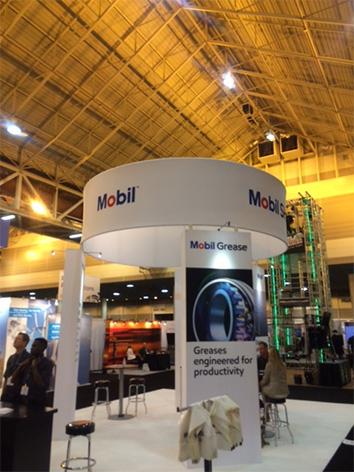NEW ORLEANS—In the middle of the sprawling Ernest N. Morial Convention Center this week, an executive from German industrial giant Siemens gave a quick history of the offshore wind turbine. The first turbine that Siemens planted in the North Sea off of Denmark 25 years ago had a generating capacity of 450 kilowatts and barely stood above the waves. Today, he explained, as waves of people drifted past, Siemens builds massive turbines with blades that are roughly equivalent to the wingspan of a jetliner—and that can generate nearly 16 times as much power.
It was a pretty good metaphor for the growth of the wind industry. You can judge a lot about an industry by the vibe at its trade show—in this case, the American Wind Energy Association’s annual WindPower expo. While the growth of wind-powered electricity has been driven in part by subsidies, environmental concerns, and a desire to move away from fossil fuels, wind now stands high above the waves as a brawny, established, thoroughly industrial business.
Wind accounts for only a small portion of overall U.S. electricity production—about 5 percent—but it’s rapidly taking more market share. Last year, the industry brought 8.6 gigawatts of new capacity on line, up 77 percent from 2015. Another 10 gigawatts of wind farms are under construction. It’s the fastest growing component of the American power sector, and the industry believes it can double in size by 2020.
Beyond gaining critical mass, the renewables industry—and especially wind—has shed its rustic, alternative, off-the-grid origins to become a mainstream corporate affair. The mantra I heard, over and over again, was that the conversation surrounding wind energy no longer had to involve the controversies of climate change and emissions limits. People are embracing wind energy simply because it is a good business decision. I moderated a panel about corporate direct purchases of wind energy, which have exploded in the past couple years. One of the participants was Mark Vanderhelm, director of energy at Walmart, which last year agreed to buy much of the output of a big wind farm in Texas. Vanderhelm noted that the ultimate decisions on purchasing are subject to the same rigors as every other procurement item at the company, which is known for its obsessive focus on price to the exclusion of pretty much every other factor. (The pricing of long-term electricity contracts is complex, but wind can now hold its own against energy produced by coal and natural gas.)
While the most aggressive mandates surrounding renewables and emissions come from the coasts, wind is a squarely middle-American industry. There were few people with jeans or ponytails walking around. Instead, it was thick with engineers. The big turbine- and blade-makers occupied the central spaces on the exhibition floor—Siemens, Vestas, and General Electric. But they were surrounded by scores of the ancillary businesses that make the industry work, the people who supply the equipment, materials, and labor. Scale models of gearboxes and power tools abounded—Hardide Erosion Resistant Coatings, Forbes Brothers power line construction, general contractor Reed & Reed, which erects turbines. The ball-bearing maker Timken was here, and so too were International Tower Lighting and Elk River, the specialist in personal-fall protection gear (constructing and maintaining turbines requires workers to scale several-hundred-foot-high turbine hubs). Most of these were staffed by men and women in khakis and polo shirts with corporate logos. There were also guys in expensive suits, but no ties: financiers, bankers from Wells Fargo, and private equity players who specialize in matching investment capital to projects.

Daniel Gross
In the world at large, renewables seem to be painted as a zero-sum game. If you regulate emissions, or invest in carbon-free electricity, that’s bad news for other industries, especially those that rely on fossil fuel. On Wednesday, as people attended a session on how to advocate more effectively for wind energy (message: couch it as a local matter of business development, not as a solution to global warming), shareholders at ExxonMobil voted down a series of measures aimed at forcing the company to reckon with climate change and become a bigger player in the transition to a lower-emission future.
But the truth is a bit more complicated, because ExxonMobil and other fossil fuel companies are already making their peace with wind energy. After all, this is a big industry, and ExxonMobil makes products that help the industry work. Turbines, gears, engines—all this equipment needs lubricants to run smoothly and effectively. And the companies attending the wind conference are big purchasers.
The notes I took for this article were written on a pad that bore ExxonMobil’s winged-horse symbol. I had picked it up at the company’s prominently located booth, where staffers stood ready to explain how fossil fuels could be used to make wind power more effective: “Mobil: Greases Engineered for Productivity.”
